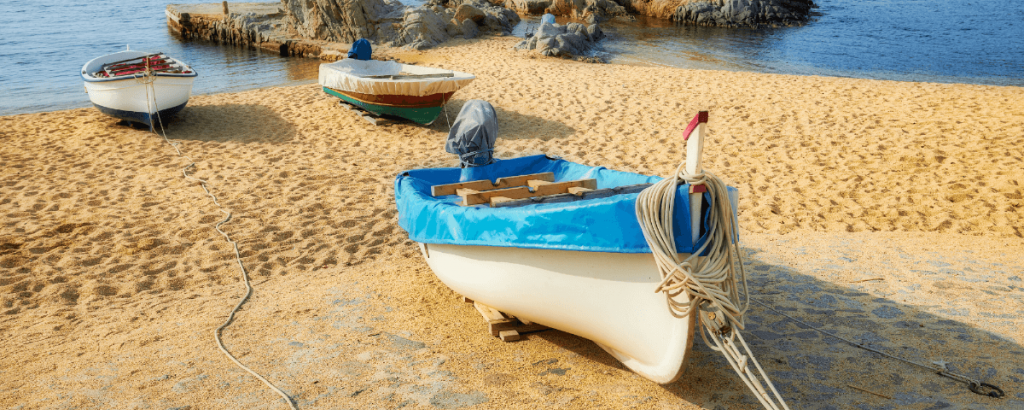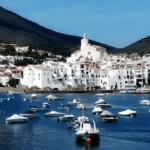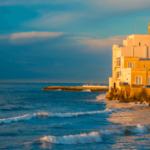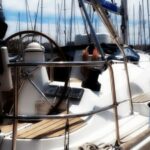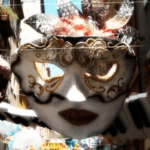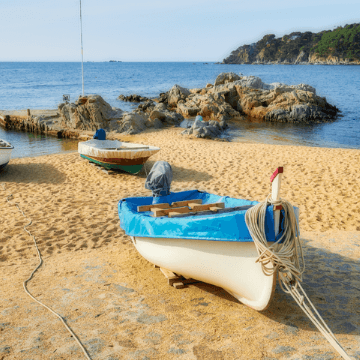
Best Catalan Beaches (Catalonia, Spain)
DISCOVER THE CATALAN BEACHES THAT LOCALS LOVE
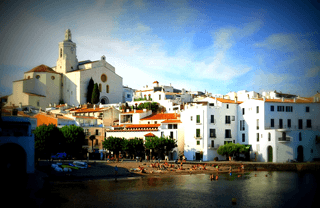
Catalonia boasts over 500 kilometers (310 miles) of coastline, offering a wide variety of beaches to explore. If you are looking forward to spend a whole day of relaxing by the beach away from the nice and the hassle of the big city, here you'll find stunning natural beauty that includes long stretches of golden sand, rugged cliffs, and crystal-clear waters. Whether you prefer a tranquil cove or a bustling beach, the Catalonia beahces offer a wide range of options to suit every preference. Discover them with us!
Costa Brava, the Northern Catalonia beaches
1
The beaches of the Cap de Creus
Cap de Creus is a stunning cape considered the easternmost tip of Spain. Its unique geological formations, including bizarrely shaped rocks are a protected natural park with dramatic landscapes and wild rocky beaches. Here you’ll find some of the best Catalonia beaches:
Port de la Selva
A whitewashed fishing village with a quiet feel, perfect for families with small kids, and mostly frequented by Catalan people and French tourists that come here because of the proximity of the border. The main beach of the village is a sandy bay with tranquil waters. But if you don’t mind rocky beaches, as you walk towards the end of the village and past the marina, you’ll start finding small coves between rocky formations, where often fishing boats moor. A short car ride will take you to the beautiful Cala Tamariua. And if you don’t mind hiking, you’ll be able to follow well marked paths to the more secluded Cala Galera, Cala Cativa or the small bay of Cala Tavallera.
Cadaques
This Catalan beach was made famous by Salvador Dalí, who spent part of the year here. This whitewashed fishing town will make you feel like you are all of a sudden in Greece. Cadaques remains the secret spot for artists, bohemians and high society all at once. Let us take you to Cadaques for a day!
The village beaches have a view to the iconic rocks of Es Cucurucuc. The Platja de Port d’Alguer is famous for the portico-ed houses around it. In the village outskirts you’ll find the bay of Portlligat, where Dali’s wife Gala used to row a boat and set her swans free to swim. And Cala Jugadora and Cala Culip are rocky beaches near the protected area of Tudela displaying a magical lunar landscape.
Roses
Roses is a larger beach town located in one end of the Gulf of Roses – a sandy break from the rocky cliffs of Costa Brava. And while you can follow the “Cami de Ronda” hiking path along the coast to reach rocky coves such as Cala Montjoi or Cala Murtra, you’ll also find sandy beaches with beach beach clubs and restaurants as Canyelles Petites, or L’Almadrava, and long and well equipped urban beaches such as Platja del Rastell and Empuriabrava.
2
More beaches in Alt Empordà
Sant Pere Pescador
A long sand beach with natural dunes, and often wind conditions that allow for paragliding and surfing. The beach goes from the Gola del Fluvià, where the Fluvià river ends, all the way to the archaeological remains of Empuries.
Empuries
This is the first place where first the Greek and then the Roman entered the Iberian Peninsula 2000 years ago. They created settlements by the beach that are now one o the largest archaeological sites in Catalonia. On its beach by the charming hamlet of Sant Marti d’Empuries, it’s possible to snorkel over some of those ancient ruins.
L’Escala
L’Escala is a larger fishing town, best known for its delicious anchovies. It’s got small urban beaches of thick sand, as well as natural beaches in its outskirts such as Platja del Rec, where the pine trees almost reach the water.
3
Beaches of Baix Empordà
The Baix Empordà is the central area of the Costa Brava, full of small quaint seaside villages and rocky coves of a warm Mediterranean feel. You’ll find here small rocky beaches, old lighthouses and impressive cliffs. Barcelona people choose Calella and the surrounding towns for their family vacations. We cover it in our Full Day Excursions To Costa Brava.
Begur
Begur is a lovely village with an stylish Ibiza feel (minus the party), but it is located inland. You’ll need a car to reach its famous beaches from there: the nudist Illa Roja, with a tall rock towering in the middle of it, the popular Sa Tuna, and the stunning Aiguablava.
Palafrugell
Palafrugell is another inland town, famous for its local market, with seaside neighborhoods that need to be reached by car from it. Tamariu is an idyllic bay surrounded by private residential areas (but public beaches, because in Spain it’s forbidden to privatize the coastline). Llafranch is a small seaside village with a relaxed feel favored by well-off Catalan families. And Calella de Palafrugell is the fishing district of Calella, a paradigm of Mediterranean small port with fishing boats moored in the sand, whitewashed houses with arched porticoes.
Palamos
The largest fishing port in the area, and also a small port for cruiseships of reduced size, it features a long sand urban sand beach with convenient parking facilities and an interesting restaurant offer. For a more natural setting, locals head to the beach of the Castell, and the beach of la Fosca, named after the dark rock in the middle of it.
4
La Selva beaches
Tossa de Mar
You’ll find in Tossa de Mar one of the most striking views: the only medieval fortress by the sea in Catalonia. It towers over two beaches, in one side the urban Platja Gran, in the other the smaller but scenic Es Codolar. At the other end of Platja Gran you’ll find the Platja de la Mar Menuda, and at the end of it a small cove known as “Banyera de les Dones” (Ladies’ bathtub), used by scuba divers to enter the water. Outside of the village there’s many virgin rocky beaches, most of them only accessible on foot or by boat: Cala Futadera, Cala Giverola, Cala Pola, Cala Morisca, Cala Porto Pi… Being only one hour from Barcelona and Girona, it is a great idea for a day of beach and sightseeing. We offer 6-hr half day tours to Tossa de Mar, too!
Lloret de Mar
While many Catalan people consider Lloret a low-quality party ghetto, the truth is that if you take the “Cami de Ronda” hiking trail along the coast you can reach spectacular secluded coves. Sa Caleta and Cala Boadella are some of the best examples. Santa Cristina and Platja Fanals are semi-urban beaches in second-home communities of the suburbs of Lloret.
Blanes
Another important fishing port, Blanes is where the Costa Brava officially starts: right on the Sa Palomera rock in the main beach of the town. For more natural beaches, try Cala Treumal (on the border with the municipality of Lloret) and Cala Sant Francesc.
Costa del Maresme, the beaches near Barcelona
5
Between Blanes and Mataró
Sant Pol de Mar
A tranquil fishing village, only internationally known for being the home-town of Carme Ruscalleda, a female chef awarded multiple Michelin stars. While her flagship restaurant closed some years ago, her family continue to run a very nice restaurant there. Luckily, most well-off people that come to Sant Pol de Mar for the food aren’t aware of its lovely beaches.
Canet de Mar
A village that stands out for its modernist architecture (architect Domenech i Muntaner’s wife was from there), it features two long urban sand beaches of about 1 mile long each.
Arenys de Mar
Another important fishing port at a local level, Arenys has two urban sand beaches (one of them shared with Canet de Mar), another one located in the outskirts called Sa Musclera, with a nudist section, and the small coves of Roques de Sant Lluc and Punta del Canadell, that from time to time lose their sand to the storms and the waves.
Caldes d’Estrach (aka Caldetes)
A holiday destination of the wealthy Barcelonans in the early 1900’s, that came here attracted by their thermal waters (“aquae caldae”, in Latin) – now they can only be enjoyed in a local spa. The village features two nice urban beaches.
Sant Andreu de Llavaneres (“Llavas” in the slang of the local posh youngsters)
Maybe it was the two golf clubs in the area what turned Sant Andreu de Llavaneras into a local posh meeting point. The village features two sand beaches, one next to the station and the marina, and other one long the coastal road.
6
Between Mataró and Badalona
Mataró
Mataró is a larger town of fishing and industrial past, where Antoni Gaudi built an industrial pavilion as a young man. Mataró features several urban beaches, all of them well equipped with showers, beach bars, wifi… Platja del Varador access for wheelchairs and a variety of sport facilities. Platja de Ponent is dog-friendly. Sant Simó has a nudist section, and from it you can access the more rustic Platja del Fortí. Callao beach is family-friendly.
El Masnou & Ocata
Two urban villages with all the necessary equipment for a comfortable beach time: lifeguards, showers, wheelchair access, kids playgrounds, sport facilities… Their location by the train station makes them a favorite of Barcelonans looking for a less crowded beach not far from the city.
Costa Barcelona, city beaches and more
7
Beaches of Badalona
Badalona is a large town whose beaches have an iconic image: the “Pont del Petroli” – a metal structure looking like a bridge that is a remaining of an old industrial facility. But besides this, there’s a nudist beach (Platja del Coco), a couple of nautical clubs and several businesses organizing sailing activities.
8
Barcelona beaches
All the 7 beaches in Barcelona, a couple of miles in total, have amenities such as showers, restrooms, sunbed rentals, and lifeguard services. They are easily accessible by public transportation, and the promenades are lined with restaurants, cafés, and shops, allowing visitors to enjoy a variety of dining and entertainment options. It’d take more than the scope of this post to describe them in detail, so let me refer you to this other post about the beaches of Barcelona for further information.
9
El Prat de Llobregat
While more difficult to reach by public transportation (because you’ll have to take the train, and then a public bus to reach them), it’s hard to believe that there are such natural beaches just 20 minutes drive outside of Barcelona. What used to be a degraded area with polluted water, has been recovered and transformed into dunes full of wildlife and long sand beaches dotted with friendly beach bars.
10
Castelldefels
Another area that has gone through a full recovery after a decade of decadence. A run down beach town that had seen better times is now home to FC Barcelona players and wealthy professionals. And the beaches have restored their natural dunes accessible by train, while the boulevard alongside the coast is now a lovely walkway dotted with relaxed beach bars serving great food.
Costa del Garraf, beaches south of Barcelona
11
Casetes del Garraf
This scenic small beach closed in by the railway stands out by the look of the vintage green and white beach houses in one side, and the restaurant over the cliff to the other side (a restaurant that has appeared in movies such as Cheetah Girls 2).
12
Sitges
Sitges is the most famous seaside town in Garraf. Cradle of the Barcelona Modernism, gay resort but family friendly beach town, home to a fun Carnival as well as international cinema and dancing festivals. It’s most iconic beach is that of Sant Sebastia, located in the heart of the Sitges Old Town. At the other side of it extend long sand beaches, and along the winding Garraf road you’ll find coves such as Balmins, and down the road past the Terramar golf club you’ll find other, such as the Platja de l’Home Mort.
13
Vilanova i la Geltru
It is said that if Vilanova and Sitges switched locations, people wouldn’t bother going to Sitges because Vilanova is also beautiful. It features almost 7 km / 4 miles of fine sand beaches. From them stands out the Platja Llarga, a recovered area of marshalls and dunes considered one of the few virgin beaches in Catalonia. Here nest protected birds and thrive other types of local wildlife.
Costa Daurada, golden sand Catalan beaches
14
The Beaches between Cunit and Tarragona
While there’s several quiet beach towns frequented by locals past Cunit, we are going to focus here in the best and most remarkable of them.
Altafulla & Tamarit
In one of the ends of Altafulla you’ll find the virgin beach of El Canyadell. Then, the long beaches of the Altafulla old town finish with the scenic view of the Tamarit Castle rising at the end. At the other side of the Castle you’ll find the smaller and beautiful Platja de Tamarit.
Roca Plana (Calabecs) and Cala Fonda (Waikiki or l’Arboçar)
Not far from the Tamarit Castle, an easy hiking path enters the protected pine woods of Torre de la Móra or La Marquesa. In a few minutes you’ll reach the coves of flat rocks (“Roca Plana” means “Flat Rock”) frequented by nudists and families with green values. If you continue the path down the woods, you’ll reach a sand beach called Platja de l’Arboçar, as well as Cala Fonda and more popularly, Waikiki. It’s also a nudist friendly beach, with a California feel. Waikiki can also be accessed from the nearby Platja Llarga in Tarragona, but the walk is longer and the descent to the beach is more difficult from that side.
15
Tarragona
The city that was once (for a short period of time) the capital of the Roman Empire outside of Italy, also features lovely fine sand beaches just minutes from the ancient Tarragona roman ruins. El Miracle, La Savinosa, L’Arrabassada, Capellans, Platja Llarga… You can try a different one each day until you find your favorite.
16
Salou
Probably the largest beach resort of Costa Brava, Salou and la Pineda experienced a huge growth with the construction of the Port Aventura theme park. Its strategic location, close to all the cultural and natural attractions of the Tarragona Province, helped establishing them as a European Summer destination. And its over 20 pretty beaches, just add up to their attractives. Cala Font, Llenguadets, Cranc, Penya Tallada and Platja Llarga are just some of our favorite.
17
L'Hospitalet de l'Infant
Sandy beaches for a tranquil Summer: the white houses along L’Almadrava, the protected sands of Cala Justell, the Neptune grass beds of Cala Bea… And if you are a skilled swimmer or can row, a small beach inside the Cova del Llop Marí cave, that can only be reached from the sea.
18
Beaches of the Ebre river delta
The Delta of the Ebro River is a unique and beautiful natural area considered one of the largest wetland areas in the western Mediterranean. Besides its great ecological importance, it’s also a wonderful vacation destination due to its infinitely long sand beaches. Don’t miss the two most famous, one at each end of the Delta: Platja del Fangar and Platja del Trabucador.
RESEARCHING FOR A TRIP IS TIME-CONSUMING…
Need more inspiration?
Our 100% FREE Barcelona Collection will give you everything you need to organize the trip of your lifetime to Barcelona.
BEST INSIDER TIPS FROM THE PROS!


